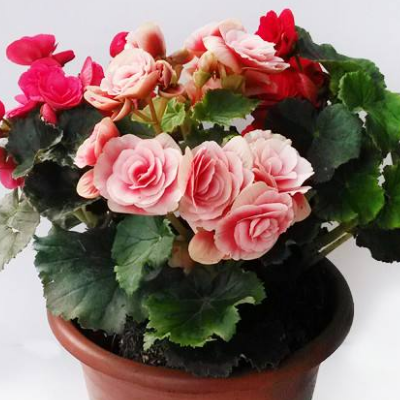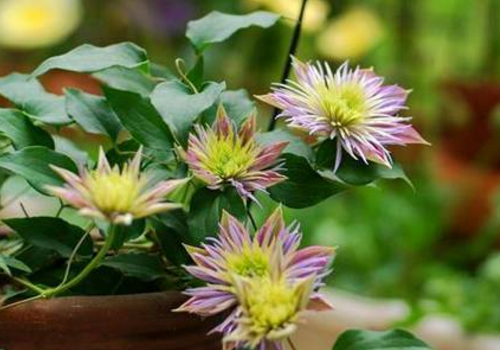The difference between the breeding method of Clematis and Clematis
There are many propagation methods of clematis, which is a kind of plant with good growth, which is suitable for ornamental plant, so the propagation method of clematis? The difference between rotor lotus and rotor lotus?
Propagation methods of clematis:
1. Cutting propagation of clematis.
Cutting is the main propagation method for hybrid clematis. The semi-mature branches were taken from July to August and intercepted in the middle of the internodes (that is, the upper and lower nodes), with 2 buds on the nodes. The medium is made of peat and sand in half. The cutting depth is just above the bud on the node. The base temperature is 15-18 ℃. After rooting, put up a 3-inch basin and spend the winter in an anti-freezing hotbed or greenhouse. Change the 5-inch basin in spring and move it out of the room. Shade and showers are needed in summer and planted at the end of October.
2. The method of sowing and breeding Clematis
High-quality varieties can choose to sow and reproduce. If it is sown in spring, it can germinate in 4 weeks. Sow in autumn and germinate when spring is warm. However, some seeds can only germinate after low temperature vernalization and grow normally only when the first pair of true leaves appear. Some varieties need to go through two stages of low temperature. After vernalization treatment, the seeds should be refrigerated in 0: 3 ℃ for 40 days, and it takes about 9-10 months to germinate. It's a long time, waiting quietly.
3. The striping method of clematis
In March, the mature branches of last year are pressed, usually taking root within one year.
4. Grafting method of clematis
Clematis hybrids, such as clematis, can be grafted on a single scion to the rootstock by split grafting, with 2 buds on the node and 5-10cm under the node. Grafting in a heated and closed environment is easy to promote survival.
5. The split method of clematis.
Generally up to 3-4 years old plants will form clumps, tufted plants, can be divided.

Generally fertile and good drainage matrix can be used for planting clematis. We selected the substrate mixed with peat and pearlite in the ratio of 3:1 or 2:1, the EC value of the substrate was controlled between 60~80mg/kg, and the pH value was controlled between 5.8~6.5.
Support: The final size and growth of clematis depends on the support. The support should be small (less than 1.5cm in diameter) so that the petiole can be entangled. The support can be made of thin bamboo poles or plastic wire netting, etc., with a height of 1~2m.
Basin: The basin should be at least 35cm deep and 25~30cm wide, of course, the bigger the better. Pots are best made of wood or pottery, which is not only beautiful, but also conducive to the growth of Clematis roots.
planting
Before planting, cut the stem of Clematis to 30cm high, which is beneficial to its branching and can avoid the stem being damaged during planting. Clematis stem base should be 3~5cm below the soil surface, plant placed in the appropriate depth, covered with soil, compacted, watered.
Clematis roots like cool environment. Covering 3~5cm thick mulch (such as bark, moss, etc.) on planting substrate can provide a good and cool root environment, which is conducive to the growth of plant roots.
The planting time is arranged in March to May or September to October.
Read the above introduction on Clematis culture and propagation methods, do you have more understanding of Clematis culture and propagation, want to know more about Clematis knowledge, please continue to pay attention.
- Prev

When does Rieger Begonia blossom and what are the propagation methods?
Rieger Begonia is a very good name, and it is a very suitable ornamental plant, so find out when Rieger Begonia blossoms and what are the methods of reproduction? When does Rieger Begonia blossom: Rieger Begonia blossoms for a long time, from April to December
- Next

Culture methods and matters needing attention of Clematis how to wither
Clematis flowers and colors of many people, so it is more suitable for family ornamental plants, so clematis culture methods and points for attention? What if it withered? Clematis culture methods and matters needing attention: clematis soil requirements, like fertile, well-drained alkaline loam, avoid stagnant water. The most important thing is that the basin soil must be ventilated.
Related
- Fuxing push coffee new agricultural production and marketing class: lack of small-scale processing plants
- Jujube rice field leisure farm deep ploughing Yilan for five years to create a space for organic food and play
- Nongyu Farm-A trial of organic papaya for brave women with advanced technology
- Four points for attention in the prevention and control of diseases and insect pests of edible fungi
- How to add nutrient solution to Edible Fungi
- Is there any good way to control edible fungus mites?
- Open Inoculation Technology of Edible Fungi
- Is there any clever way to use fertilizer for edible fungus in winter?
- What agents are used to kill the pathogens of edible fungi in the mushroom shed?
- Rapid drying of Edible Fungi

